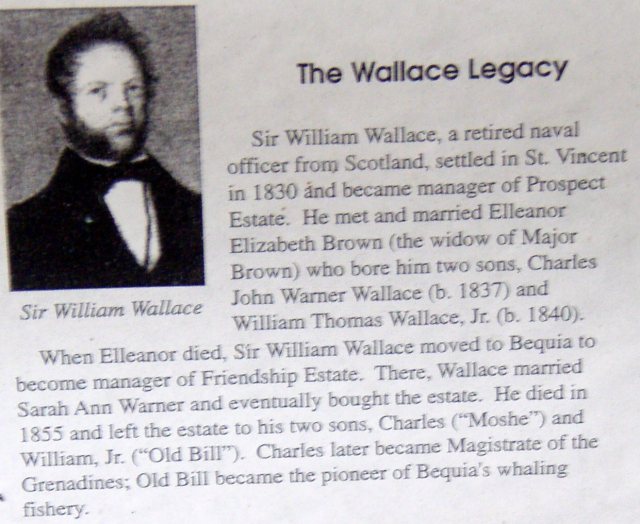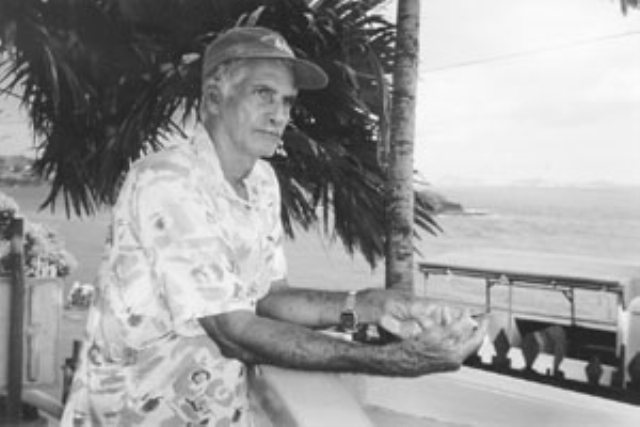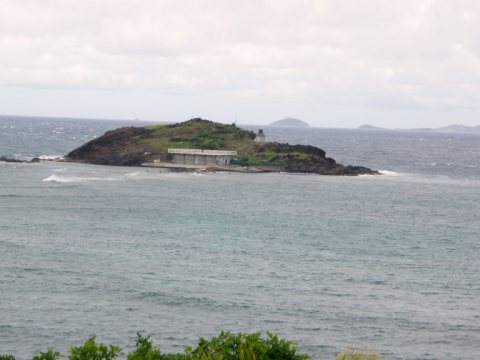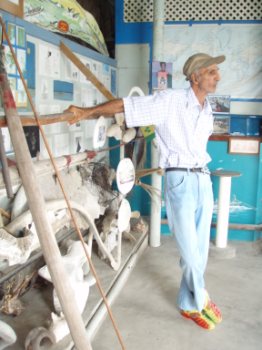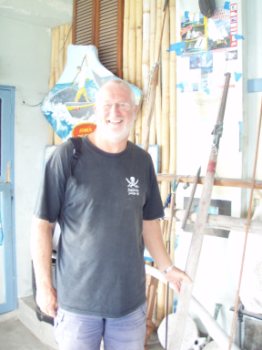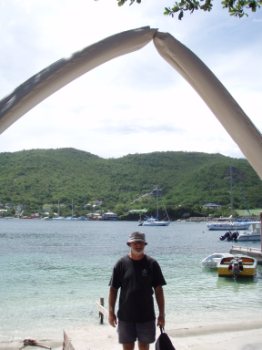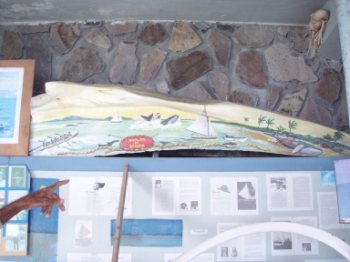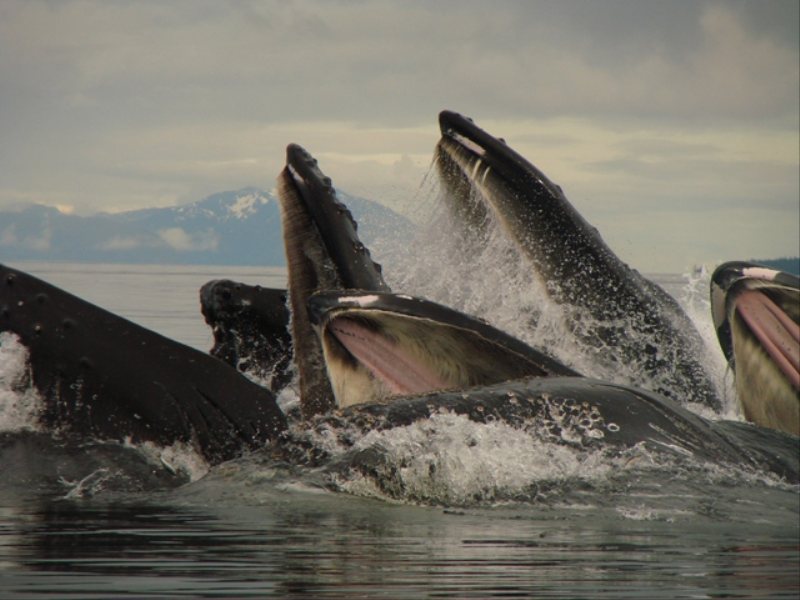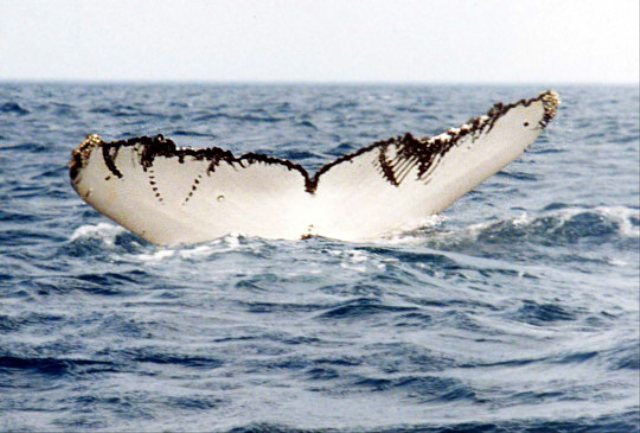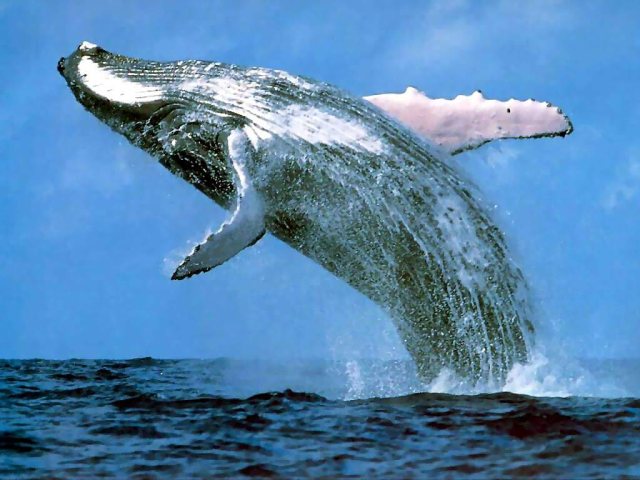Whaling Part Two

|
WHALING
The best writing I have found to sum up the life and impact of whaling in this community is the following eulogy written by Horace Beck for Athneal Ollivierre perhaps Bequia’s most famous whaler:
Horace Beck wrote: On
the fourth of July at five o'clock in the evening Athneal Ollivierre died in La
Pompe, Bequia in his home which faced the sea where he had spent most of his
life. Athneal was in his eightieth year and with his passing an era came to a
close. Bequia, and the West Indies, had lost perhaps their finest citizen. The
world had lost a mighty man. I had lost a very dear friend.
People
always are perceived in two different ways. They appear one way in their own
culture and in another way to those outside that culture. As an outsider from
afar I can only speak of Athneal as he appeared to me, although my wife and I
had the advantage of spending many years in the islands gaining informal
instruction as we came and went. In
1924 I witnessed the last active American whaleship, the Wanderer; break her
back on Sow and Pigs Reef in Buzzard's Bay, Massachusetts. Later I rowed in her
salvaged whaleboats. I lived in an ancient whalerman's house. I had ancestors
who were whalers. I loved the sea. Later I met Dwight Long who had visited
Bequia in the late twenties, and mentioned the whaling there. Still later I met
Fritz Fenger who had visited the islands years before in his sailing canoe. He
talked of "Old Bill" Wallace, the founder of whaling in the islands. I
determined to go there and fitted out a small schooner for the purpose, but the
war came on and put a stop to that and it was not until years later that I was
able to trundle over from England to Tobago and work my way up the islands. We
were in Carriacou talking to Dean McFarland when a young boy came in and
announced, "They kotched de whale in Bequia." Fifteen minutes later we had
"opened sail" and were off. But when we arrived the whale had already been
attended to. We were directed to talk with Louis Ollivierre who said nothing about his brother Athneal and it was only by accident that we discovered the quiet, thin man with the hat was Athneal the whaler. When we did finally approach him he was always polite, non-committal, and quickly moved away. After more than two weeks watching the boats "push out" in the morning and helping to haul them ashore in the evening Arlington Richardson, the boat steerer known as "Second", took pity on us and persuaded Athneal to take me aboard. Next morning he said, "You can come." That evening he elaborated, "You can come anytime. You like a sprat in the boat," which was one of the most satisfying comments I ever heard about my aquatic ways. From that time on for over ten years I stuck to Athneal like a pilot fish and he taught me, not only whaling and its history in the islands but about Bequia life as well.
Old
Bill Wallace had spent years at sea, much of it in New Bedford whalers, and had
even spent time in New Bedford learning to build the thirty-five foot whaleboats
used to harpoon the whale. And which subsequently became the boat of choice for
all Bequians. When he retired from the sea in 1870 he returned to Bequia and set
up whaling "companies" consisting of four whaleboats and about 26 men per
company. Each company was given a name, "Old England", "St. Hillary", South
Side" and so on. The crews were given uniforms which included a walking stick, a
lunch box and a floppy hat. It was said one could tell the time by the sound of
the whalers' walking sticks as they tap, tapped past in the dark on the way to
the boats. He taught them how to approach the whale, iron it, bring it ashore,
butcher, render and eat it. He also taught them how to share the profits based
on the American share or "lay" system. Whaling
became so popular that there were whaling stations on nearly all the islands and
some say as many as eight, certainly four companies on Bequia. But whaling in
the islands was not profitable as a modern geographer, John Adams, has pointed
out and it soon died out except on Bequia where it continued to flourish.
Unfortunately for the economist and the geographer and fortunately for the rest
of us, profit is not always counted in monetary terms. Because of whaling the
people of Bequia became known as the best seamen, the bravest and the most
honest of all the islanders. Bequians recognized this and made every effort to
keep their star bright. Foremost
among the whalers was the harpooner and among the great harpooners the name of
Ollivierre stands out. Josie and Napoleon Ollivierre were ancestors of Athneal's
and their feats of skill and derring-do are still talked about all over the
Caribbean, as are other members of this family, originally from France, who
chose to be sea captains rather than whalers. Young
Athneal chose the big ship legacy and became skipper of a large schooner, the
Turtle Dove, trading amongst the islands as far down as South America and up
beyond the Virgins. At that time nearly all freight was carried by sailing
vessels but the small freighter had begun to make an appearance. "Engine boats"
they were called and began to make inroads until today scarcely a freighting
schooner can be found. While captain, young Athneal established a reputation
throughout the islands so strong that years later old heads when asked will say,
"Captain Athneal of the Turtle Dove? Oh I knew him well" and proceed to tell
stories about him as a seaman or as a trader. During
his career in the schooner trade the dashing young captain met a lovely young
woman from Venezuela who was related to the Hazell family of Bequia. Having been
orphaned she came to her relations in Bequia initially speaking only Spanish.
She and Athneal fell in love, married and formed a union that had had far
reaching effects over the years for both of them. Not
long after their marriage the Turtle Dove was coming north to leeward of the
islands when she ran into heavy weather, was driven even further to leeward and
started some of her seams. It was all hands to the pumps as the wind abated and
then fell calm. The water gained on the pumps but Athneal stuck with the vessel
and slowly managed to beat to windward. The crew became exhausted but her
skipper kept nudging her to weather. Eventually they sighted land which they
slowly closed. She was floating on her timberheads when they finally left her in
the shore boat and she sank moments later taking most of the captain's fortune
with her. All hands reached shore. And Athneal went home. After
World War II the Norwegians established a whale factory on Pigeon Island off
Grenada. It is said that the first year they took 700 whales, the next 400 and
the third less than 70. Since 70 whales was not enough to support a factory, the
station was abandoned and the Norwegians went home. It was 11 years before the
people of Bequia saw another spout. The fishery there, already in trouble,
collapsed after the Norwegians left. Gradually
the number of whales increased until the Ollivierres decided to start whaling
again and Athneal threw in his lot. The gear was all there. Uncle Joey, an old
harpooner, was still fit for sea and there were willing hands. There was Lincoln
"Bluesy" Simmons, the sailmaker and the only man who still knew how to butcher
the whales, very much alive and ready to go. And there was a ready demand for
the oil, the meat and even the bones of the whale. There was now only one
company, two boats instead of four: the Dart and the Trio. Athneal named the
latter, indicating he was willing to try again. Athneal went as harpooner in her
and his brother Barton went in the other, but Barton, sitting in the fig tree
lookout stand on Mustique Island, spied a whale, lost his balance, fell, was
caught in the crotch of a limb and broke his neck. He survived but never was
able to whale again. The
harpooner was a man with endless qualities in his character. He was immensely
powerful although he merely appeared lithe. He could throw a 40-pound harpoon
with line attached as easily as an athlete could handle a javelin. He could sink
that harpoon three feet into a whale and once fast it was not long before he was
on the whale's back driving the lance six feet into its vitals. And Athneal was
also a man of great courage. Only
a fool is fearless. Ordinary people have many fears, some brought on by personal
revulsion, some engendered by culture, some real. Those who confront these fears
when there is an alternative are courageous. When they confront them to aid
others they are heroes. Athneal fits all the criteria. In Bequia there is a firm
belief in "jumbies", spirits that can destroy you. One moonlight night Athneal
was walking through Lowbay Gutter, a spot believed to be infested with
malevolent spirits. Suddenly there was a weird squalling and down the track
toward him hurtled a dark and white shape. "I thought it was a jumbie come to
destroy me so I pick up a heavy stick and say to myself, `it may destroy me but
I must give it a lick to remember.'" While others would have fled he set himself
and gave the object such a lash it fell apart. It was a feral ram cat attached
to a small white goat. The goat survived. One
day far out in the channel they got fast to a whale. The whale sounded, the line
fouled the loggerhead and the boat went under, bow first. The crew were thrown
out but Athneal was tangled up forward and went deep before he could cut himself
clear. Just as he surfaced he looked down and saw a large shape rising toward
him. Thinking it was the whale coming to attack he readied his knife and dove to
attack it. It was the whaleboat, clear of the whale and clear of its ballast,
rising bottom up to the surface. Once on the surface Athneal gathered the crew,
turned the boat over, collected the drifting gear, bailed her out and limped
home. Athneal
was a man loyal to his friends beyond reason, for which I am eternally grateful.
On one occasion my engine had given out and it was necessary to replace it. The
engine was ordered and arrived in St. Vincent where it immediately became
involved in red tape, and the harder we struggled to unravel the difficulties
the more complex they became until it looked as if the engine would belong to
the government. I mentioned this to Athneal and the next morning he had
vanished. Late that afternoon he arrived with the engine in a crate. I asked him
how he got it. "Why I tell them I must have the engine and if I must come back
again I will come with my whale gun and bomb the place." Athneal
had a natural grace that put him on easy and equal footing with everyone. He was
as easy and comfortable talking with Princess Margaret, a business tycoon or the
poorest wretch on the island. Somehow he even managed to suffer fools without
rancour or scorn. One day a young female tourist asked if he had just returned
from whaling. "Where are your whales?" "In the sea, madam." "No whales? I don't
see any whales. I don't think you are a whaler. If you are, where is your net?"
"Madam, whales is not sprats in the sea. Have a good stay in Port Elizabeth."
In
a society that put great store on children. Hilda and Athneal were childless but
both loved children dearly and the house was always full of them, some sleeping,
some pushing "rollies", others eating a snack while others listened to stories
told by Athneal or Hilda. Despite the fact that Hilda was childless, she held an
important place on the island. She was the best cook on the island and her cakes
and other delicacies were sought after throughout Bequia. (Over the years she
gave my wife more than a hundred recipes all excellent including robins, "dove
whale", frigate bird and delicious wedding cake.) But
Hilda was also a confidante for the women of the island and her advice was often
sought out. Beyond this she was believed to be able to interpret dreams, had
second sight and was able when the circumstances demanded to bestow a curse.
Certainly it is true that nearly every whale that Athneal caught had been
foretold by Hilda and when one of the captain's relations lost a hand in an
illegal explosion she wished that the person who peached on him would suffer the
same injury and so it came to pass. The two made an impressive team and when she
died Athneal was long in recovering. In
the islands envy and revenge are bitter fruits and Athneal was often the
recipient of them. Perhaps the most galling thing to the whalers was the "lay"
provisions in how the profits from a whale would be divided. Some profit went to
the boat, some went to the harpooner, some to the boat steerer and the rest to
the crew. And it was seldom that someone was not dissatisfied with his portion.
In one case a crew member left his share of the meat outside the rum shop and
when he came out he discovered dogs had eaten it. He demanded his share be
replaced and was upset when it wasn't. Others felt Athneal was too successful
and took pains to discredit him. When he planted mahogany trees they were cut
down but Athneal held his tongue and his temper. And
then there were the tourists and the environmentalists. Some of the tourists
came to watch a whale hunt. Fearing they might miss something they rushed in and
interfered with the hunt. Others, desperate to save the whale, either tried to
drive it away or interposed themselves between the boat and the whale.
Despite
the fact that the whalers averaged only about a whale and a half each year and
that the numbers of whales had increased in 1972 to a hundred and eleven
sightings, this did nothing to dissuade the whale lovers from the conviction
that Athneal would exterminate the species. They did everything they could to
stop the hunt and were not above distorting facts and printing scurrilous
reports which the whalers had to endure. Fortunately whaling in Bequia was very
good for the coffers in St. Vincent, since it was a unique tourist attraction.
The St. Vincent government was slow to restrict or outlaw it but restrict it
they did, each year making whaling a little more difficult.
More
formidable for the whalers was the change taking place in Bequia. When we first
arrived the only way to get there was by island schooner or sailboat. The roads
were few and poor. There were more donkeys than cars. Today there are no donkeys
but plenty of autos. One can helicopter to Bequia. Very little of the island had
electricity when we first came. Now the island is electrified and television
takes precedence over conversation in the rum shop. The standard of living has
gone up and people can earn more serving tourists than they can chasing whales.
Through
all this Athneal carried on. He had been injured in a whaling accident. His
sight was failing and he had cancer and was given only a short time to live.
Whaling, it was said, was finished. Yet he gathered himself together and 2 years
ago put to sea and caught a whale. In November of last year, swells from Hurricane Lenny hit the island from the back side. They did great damage to Port Elizabeth and destroyed the whale factory on Petit Nevis. The whaleboat, Why Ask? was in the shed which fell on and split it down the middle. Somehow Athneal repaired the unrepairable boat, survived long enough to go again in the boat last winter and taught his nephew Bentley how to hunt the humpback. Under his failing eye Bentley struck and killed two whales. Having passed a tradition and the harpoon on into younger hands Athneal had done all he could to ensure whaling would live on. Having done his best he turned his face to the wall and passed away.
As we look at the old whaler's life one thinks of a poem by Rudyard Kipling called "If ". It encompasses Kipling's measure of a man. Who could better fit the ideal than Athneal Ollivierre?
We went to the whaling museum overlooking Friendship Bay. The only whaling station left on Bequia on Petit Nevis.
We met the curator Harold Macmillan, his wife was an Ollivierre, descended from the original Olivierre whalers. A whalerman's chair. Harold told us he went on his first hunt at the age of fourteen. He was one of eleven, one died in infancy. His mum is ninety eight and living as are all his siblings in Northamptonshire.
Bear holding a harpoon. Duties of a Whaleboat crew. Bear under a "lucky" jawbone outside a restaurant (they sell for a thousand pounds to tourists)
A vertebra bone. The sieves in the mouth (used to make whalebone for corsets). The story of a whale hunt painted on a nasal bone. "Growing up as a young boy the whalers were our
heroes. They were doing it for the island. It supplied us with
food." "We are still doing it the traditional way and we are
doing it for food. We are not commercial; we're not doing it like say the
Japanese." "We catch them now in exactly the same way as you may
have read in Moby Dick or as we did since
1876." Whaling in Bequia today is done just as it was when
Nollie Simmonds' ancestor, William Wallace, started it. The animal is hunted
from an open wooden boat, launched from the shore and powered by sail and oars.
"With a double ended wooden skiff, six men, some
wrought iron harpoons and a lot of rope. A lot of sweat and
muscle." Nollie Simmonds
Feeding and getting to know one another
Each tail pattern is just like a fingerprint - totally unique

ALL IN ALL AN EXTRAORDINARY TALE OF MAN
AGAINST BEAST. THE PASSION AND SKILL IS
DWINDLING IN THE YOUNGER GENERATION
|
